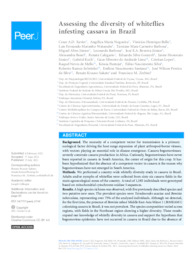Assessing the diversity of whiteflies infesting cassava in Brazil.
Assessing the diversity of whiteflies infesting cassava in Brazil.
Author(s): XAVIER, C. A. D.; NOGUEIRA, A. M.; BELLO, V. H.; WATANABE, L. F. M.; BARBOSA, T. M. C.; ALVES JÚNIOR, M.; BARBOSA, L.; BESERRA-JÚNIOR, J. E. A.; BOARI, A. de J.; CALEGARIO, R.; GORAYEB, E. S.; HONORATO JÚNIOR, J.; KOCH, G.; LIMA, G. S. de A.; LOPES, C.; MELLO, R. N. de; PANTOJA, K.; SILVA, F. N.; RAMOS SOBRINHO, R.; SANTANA, E. N.; SILVA, J. W. P. da; KRAUSE-SAKATE, R.; ZERBINI, F. M.
Summary: Background. The necessity of a competent vector for transmission is a primary ecological factor driving the host range expansion of plant arthropod-borne viruses, with vectors playing an essential role in disease emergence. Cassava begomoviruses severely constrain cassava production in Africa. Curiously, begomoviruses have never been reported in cassava in South America, the center of origin for this crop. It has been hypothesized that the absence of a competent vector in cassava is the reason why begomoviruses have not emerged in South America. Methods. We performed a country-wide whitefly diversity study in cassava in Brazil. Adults and/or nymphs of whiteflies were collected from sixty-six cassava fields in the main agroecological zones of the country. A total of 1,385 individuals were genotyped based on mitochondrial cytochrome oxidase I sequences. Results. A high species richness was observed, with five previously described species and two putative new ones. The prevalent species were Tetraleurodes acaciae and Bemisia tuberculata, representing over 75% of the analyzed individuals. Although we detected, for the first time, the presence of Bemisia tabaci Middle East-Asia Minor 1 (BtMEAM1) colonizing cassava in Brazil, it was not prevalent. The species composition varied across regions, with fields in the Northeast region showing a higher diversity. These results expand our knowledge of whitefly diversity in cassava and support the hypothesis that begomovirus epidemics have not occurred in cassava in Brazil due to the absence of competent vector populations. However, they indicate an ongoing adaptation process of BtMEAM1 to cassava, increasing the likelihood of begomovirus emergence in this crop
Publication year: 2021
Types of publication: Journal article
Unit: Embrapa Eastern Amazon
Observation
Some of Embrapa's publications are published as ePub files. To read them, use or download one of the following free software options to your computer or mobile device. Android: Google Play Books; IOS: iBooks; Windows and Linux: Calibre.
Access other publications
Access the Agricultural Research Database (BDPA) to consult Embrapa's full library collection and records.
Visit Embrapa Bookstore to purchase books and other publications sold by Embrapa.

